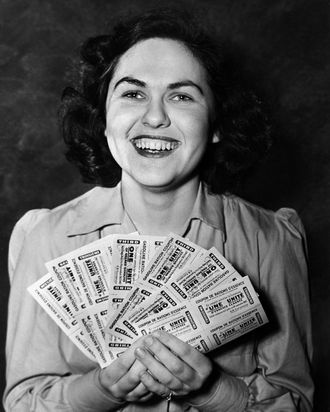
Georgia, 25, lives with two roommates in Denver and recently started grad school to become a nutritionist. She’s taken on student loans, doesn’t have much in the way of savings, and wants to reduce her everyday expenses as much as possible. She knows that coupons and online deals can be helpful, but she doesn’t have time to pore over newspapers or circulars (nor the space to buy in bulk, which feels wasteful anyway — she’s only one person). How can she take advantage of discounts to make her dollars go as far as possible, without expending a lot of energy and time?
Like you, Georgia, I am both intrigued and reviled by the concept of “couponing.” On the one hand, I like to save money; on the other, it brings to mind binders stuffed with discount slips (ugh, paper mail) and minivans piled high with 24-packs of canned corn. Lugging something I might use someday — even if it is literally free — up the five flights of stairs to my one-bedroom apartment doesn’t seem like an efficient use of energy, nor of the already-limited space I have. Plus, there’s opportunity cost to consider: If it takes me 13 minutes to page through a circular, find a coupon for Mrs. Meyer’s lavender dish soap, and snip it out, is that time worth the $2.27 that it saves me? Reconciling convenience versus price, especially for mundane stuff, is awfully tedious (it’s just detergent, after all). How do you discern the best value of your time, and what will it get you?
Even coupon experts agree that discount-chasing doesn’t always make for savvy shopping. “The truth is, couponing can lead folks to buy things they don’t need,” says Joanie Demer, a co-founder of TheKrazyCouponLady.com. “I’m famous for the time I bought 40 boxes of high-fiber instant oatmeal for my kids before trying it, only to learn that the stuff gave them ‘the runs.’”
Georgia, you probably won’t have that problem, but it does beg the question of what these deals are worth if you’re just shopping for yourself. “Larger households certainly have more to gain from couponing, but that doesn’t mean an urban-dwelling 20-something with a small apartment shouldn’t get in on the action,” adds Demer. “For example, nobody wants to pay for stuff like razors, toothpaste, and body wash. By combining coupons with drugstore sales, you’ll pay pennies on the dollar for stuff that doesn’t take up much space.” Stefanie O’Connell, author of The Broke and Beautiful Life, agrees that the boring stuff is prime savings territory. “I remember the first time I found out how much toilet paper cost, I was livid — that was not what I had planned to spend my money on,” she said.
The first step in maximizing discounts is to start with where you shop the most. “That’s where you’re already shopping for the things you need,” says O’Connell. “If you’re in a place where you’ve established your shopping patterns, it’ll give you parameters to hone your strategy and become familiar with their discount policies.”
See if your go-to stores have a loyalty savings program and, better yet, an app — chains like CVS, Walgreens, Target, and Whole Foods offer coupons that you can digitally “clip” on your phone and sync to your rewards card (or scan directly from your device at the register). This works best with some advance planning, but it’s not a huge time commitment; just cross-check your shopping list with the app before you go, or while you’re waiting in line. O’Connell also uses the app RetailMeNot, which allows you to search for coupons by store. (And if you don’t mind being stalked by the internet, it features a setting that will notify you when you’re in the physical proximity of a good deal, like a radar detector for discounts.)
You can also check couponing websites to compare prices and offers before you shop. Popular ones include Demer’s website as well as Cindy Livesey’s LivingRichWithCoupons.com (of Rachael Ray fame); both allow you to search by retailer, item, and other categories, and offer printable coupons for in-store use as well as web-only deals (and yes, they have apps, too). “We found that our site saved users an average of $180/month if they dedicated 20 minutes per week to couponing,” said Demer. That dollar amount is highly subjective, but the 20-minute rule is a good goal to shoot for — plus it encourages pre-shopping organization, which helps curb impulse buys like the high-fiber oatmeal situation.
In addition to drugstore items, some groceries are also ripe (sorry) for deals. “Thanks to rebate apps like Ibotta and Checkout 51, produce coupons are now commonplace,” said Demer. “But to save on meat and milk, you’ll just have to track prices and buy closer to expiration in order to get a discount and shop in bulk and freeze.” (Or just not bother — as a burgeoning nutritionist, you might not be into discount chicken.)
For online shopping, O’Connell recommends the browser extension Honey, which scans your shopping bag and alerts you to any current promotions that apply. “I also do basic Google searches for promo codes all the time,” she said. “It never hurts to check.”
Paper coupons in circulars and newspapers can still be fruitful, but you need to go through the trouble of looking for them, cutting them up, and being that person in the checkout line. (And in that case, follow good coupon etiquette: O’Connell suggests having all your coupons ready before you get to the cashier, and perhaps even warning the people behind you, in case they want to switch to a different line.) You can try the app SnipSnap to take photos of paper coupons instead of physically bringing them — but that only helps part of the problem.
If you’d rather steer clear of paper entirely, you’re in good company. A recent study by data-science firm Inmar found that traditional coupon redemption (i.e., using the paper variety) is on a steep decline, despite wide availability. “Today, shoppers — particularly millennials — are much less willing to put in the kind of work that traditional coupon-clipping entails,” said Anita Bhappu, a consumer scientist and professor at the University of Arizona. And although the tides of retail are slow to shift, they are turning in your direction. “We’ve found that millennials are very reward-driven in their couponing habits, and retailers are coming around,” adds Bhappu. “We use the term ‘gamification’: Millennials grew up playing games on their phones and computers, so they are conditioned to expect a reward every time they pass a level. This generation asks, ‘How can I work at this to aggregate and amass rewards, like cash or other benefits, that I can use towards things I want?’”
Indeed, that sounds like a much more appealing approach than bulk-buying. “I try not to think of it in terms of just saving money on soup or shampoo,” says O’Connell. “Instead, it’s about freeing up more money for the fun stuff.”


